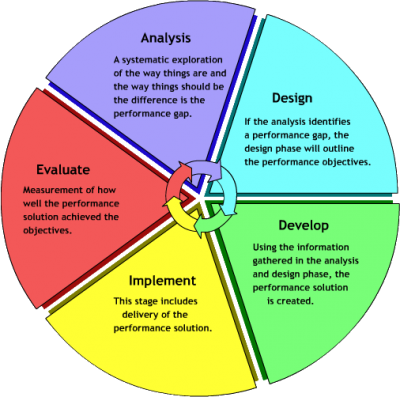I have been involved in the creation and design of courses for the fitness and personal training industry for some time. When I first started developing courses I was blissfully unaware of the vast subject area that is instructional design. Since finding this subject i have learnt a great deal about how courses can be put together in a manner that will lead to the optimal learning experience for our learners.
Over the next few posts in the fitness educator area of my site I am going to examine some of the key concepts in the area of instructional design for the fitness industry. The first model that I have decided to look at is the ADDIE model of instructional design. I am a big one for processes, having an established process to follow for given situations can help to streamline and focus your efforts. The ADDIE model is an established instructional design model that helps to guide through five stages of instructional design. The five phases being Analysis, Design, Development, Implementation, and Evaluation. These represent a guideline for building effective training and support tools, these five stages have been discussed below:-
Analysis Phase
During this phase the instructional problem is clarified. This then leads to the development of a goal and establishment of the learning objectives. There are a number of key questions that need to be addressed in this stage:-
– Who are the learners, what do you know about them?
– Are there any constraints or barriers to learning?
– What options do you have in terms of delivery?
– What timeframe and budget do you have available to you?
Design Phase
This phase is where you start to set learning objectives, assessment plans/criteria, design schemes of work, lesson plans and resources. There should be a logical approach taken to design, with a system of review and editing to ensure that courses are fit for purpose. Many designers will use a storyboard or learner journey approach to instructional design, this should lead to the development of a course that is ready for first delivery in a prototype type stage.
Development Phase
This stage sees a larger range of people becoming involved in the process with often the need for involvement from programmers, graphic designers and web developers. This is where the prototype comes together into a more polished final product. Effectively what is being developed here is a prototype course that can can into first delivery and from there go into a cycle of development and improvement.
Implementation Phase
This stage starts off with first delivery, it is suggested that initially internal candidates and technical experts work through the course. This will have the initial benefit of allowing the identification of any initial mistakes or improvements before real life students take part. This is effective the dry run phase.
The next stage is the initial delivery of the course to real learners, this stage is one where it is important not to take your eye off the ball. It is important that how the learners react and their views, problems and any comments are considered and where needed addressed.
Evaluation Phase
This stage is the on-going where a feedback loop should be implemented with regular feedback being gained from learners and tutors/assessors, this should then be fed into the instructional designers who then consider comments and make changes are updates to the course as needed.
This model is a very basic instructional design model and there have been a number of additions, re-works and updates to the ADDIE system. If you are new to considering the instructional design process this is a great place to start. We can make it more complicated as we go on!
If you have used the ADDIE system before or have any comments please do share them below!


